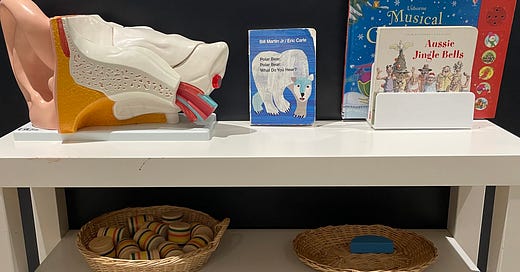Deciding on the themes for a Christmas education needn’t be an overly complicated matter. I essentially started with the first words that came to mind when I thought of Christmas and went from there. Originally, my plan was to have each theme last a day, however, sometimes with home education, some topics are just too interesting to drop. So, the theme that took us over two days, Music & Sound
Toddler/Preschooler
I’m really not going to beat about the bush, I mainly did this topic just so I had an excuse to get the giant model of an ear out. Be honest, you would too. I was very fortunate to be given this model by a friend and it is an excellent demonstration piece as it comes apart to see inside the ear. But more on that later in the science section.
For the toddler/preschooler, the main theme element for this theme was differentiating sounds. An integral concept to grasp for small children and an instrumental precursor to phonics work. The basket on the middle shelf holds our Montessori sound cylinders (similar linked here), that require the child to match the pairs of sounds when the cylinder is shaken.
The coloured handballs on the floor were the clear hit (linked here). Each one can be played by pressing the handle down, or ringing as a traditional bell. Each produces a beautifully clear and (more importantly) non-piercing sound, and is labelled with its musical note. I printed out some simple sheet music for a few well-known Christmas songs, colour coded the notes to match the colours of the bells, and left them out for the children to try.
Some Hands-on Extension Work
In our discussion about Christmas music, we listened to a selection of different songs, talking about what made them Christmassy and what we liked/disliked about them. I tasked the boys to think of rhyming words to some traditional Christmas words, before using this to start creating their own Christmas song. Could they make a number 1 hit…?
Books
As always, the age range is a guide only and shouldn’t be used as an indication it is/isn’t suitable for your child:
Polar Bear, Polar Bear, What Do You Hear? (2-5 years) - a great book to encourage children to join in with noise making
Musical Christmas (similar linked here) (1-3 years) - there are several Usborne sound books that would work well
The Story Orchestra: The Nutcracker (6-9 years) - although not generally about Christmas music, the Nutcracker suite has become synonymous with Christmas music
The Science of Christmas
Today’s work focused on sound and hearing: how do we hear the Christmas music? We used the giant ear model alongside a BBC Bitesize video (linked here) before labelling a cross-section of an ear with the names of all the parts. I use Twinkl for a lot of the worksheet type content that we do.
Discussing how the ear works led to a discussion on sound waves and vibrations, a potentially complex topic for younger children. I was fortunate to have been given a STEM kit about sound waves from a friend, and this included a tuning fork which proved a very useful tool for demonstrations. I guided the boys on how to strike the tuning fork and to then place it on different surfaces, including water, so see the vibrations.
The STEM kit also included a simple high frequency transducer which we were able to use to demonstrate sound waves that you cannot hear.
In a wonderful turn of events, we were able to go and see a choir sing at a local heritage property. Not only that, the choir were singing in a “sounding chamber”, amplifying the sound and allowing the children to see their science in action.




